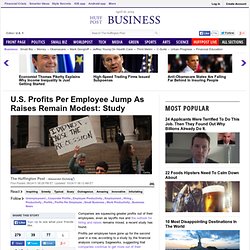

Connecticut Wage Theft Law Shifts Burden of Proof from Employees to Employers. Lawmakers in Connecticut are requiring employers caught shortchanging workers out of wages to prove their actions were unintended, putting the burden on businesses for the first time.

Senate Bill 914, approved by the state legislature and signed by Governor Dan Malloy, gives employees the ability to collect double the amount owed to them by their employers. The new law is expected to deter companies from cheating workers out of regular and overtime wages. “This is going to mean the transfer of millions of dollars each year from cheating employers to low-wage workers,” James Bhandary-Alexander, a lawyer for New Haven Legal Assistance who represents victims of wage theft, told In These Times. Before the passage of SB 914, state law placed the burden of proof on employees, who had to show “bad faith, arbitrariness or unreasonableness” on the employer’s part in addition to wage theft. Labor advocates hailed the new law, though some said it did not go far enough in punishing employers. - taz.de. Statistikprofessor Gerd Bosbach erklärt die Tricks Dr.

Gerd Bosbach ist Professor für Statistik, Mathematik und empirische Wirtschafts- und Sozialforschung an der Fachhochschule Koblenz (Standort Remagen), Forschungsschwerpunkt: Statistikmissbrauch, Arbeitsmarkt- u. Bevölkerungsstatistik (Demografie), Armut (im Alter), volkswirtschaftliche Aspekte der Gesundheitsfinanzierung. Er studierte in Köln Mathematik und promovierte nach dem Diplom im Bereich Statistik an der Wirtschafts- und Sozialwissenschaftlichen Fakultät der Universität zu Köln. 1988-1991 beratende Tätigkeit im Statistischen Bundesamt (für Wirtschafts- und Finanzministerium und wissenschaftliche Dienste des Deutschen Bundestages), im Anschluss als Statistiker bei der Kassenzahnärztlichen Bundesvereinigung.
Er erhielt tiefe Einblicke in den Umgang mit Zahlen sowie deren interessengeleiteter Interpretation und Manipulation im Politik- und Gesundheitsbereich. Herr Bosbach nimmt es genau. Letzteres trifft auf Herrn Bosbach zu. Eine Million Jobverluste in Deutschland? Zur Diskussion über die Beschäftigungseffekte von Mindestlöhnen 22.

Januar 2014 um 10:28 Uhr Die Entscheidung von Union und SPD, einen gesetzlichen Mindestlohn von 8,50 Euro brutto je Stunde einzuführen, rief die erwarteten Reaktionen hervor.[1] Bereits im Vorfeld hatte „Star-Ökonom“ („Focus“) Hans-Werner Sinn, Präsident des Ifo-Instituts, vor den verheerenden Folgen gewarnt: „Ein flächendeckender gesetzlicher Mindestlohn von 8,50 Euro würde nach unseren Schätzungen gut eine Million Arbeitsplätze vernichten“ (zit. nach Focus-Online – Ifo-Chef Sinn warnt vor Mindestlohn: „Vernichtet eine Million Arbeitsplätze“).
Unterstützung erhielt er von einem zweiten „Star-Ökonomen“ („Focus-Money“), nämlich Thomas Straubhaar, dem Direktor des Hamburgischen Weltwirtschaftsinstituts. U.S. Profits Per Employee Jump As Raises Remain Modest: Study. Companies are squeezing greater profits out of their employees, even as layoffs rise and the outlook for hiring and raises remains mixed, a recent study has found.

Profits per employee have gone up for the second year in a row, according to a study by the financial analysis company Sageworks, suggesting that companies continue to get more out of their employees as they slash their payrolls in an effort to get leaner. The findings also suggest that profits have been rising despite the lack of a corresponding increase in wages. The private companies surveyed by Sageworks reported that their profits per employee climbed to $15,278.72 in 2011 from $12,488.02 in 2010, a rise of about 22 percent for the year.
The figures for 2010, in turn, represented an increase of about 24 percent from the 2009 profits per employee, which were $10,045.56. The rise in profits per employee indicates that companies are finding ways to maximize the efforts of their workers. Men's Earnings Haven't Just Stagnated Over Past 40 Years. January 15, 2012 | Like this article?

Join our email list: Stay up to date with the latest headlines via email. Catherine Crampell at The New York Times Economix blog pointed to a disturbing article Thursday. It shows that full-time male workers in the United States were making less in real, that is, inflation-adjusted, dollars in 2009 than they were in 1969. But the picture is even worse than that. The bottom-line: Wages for men have not just stagnated over the past four decades, they've slipped. These data come from an article by Michael Greenstone and Adam Looney, both of the Brookings Institution and the Hamilton Project, the latter founded in 2006 by Robert Rubin to set forth an agenda of centrist economics for Democratic administrations to adopt. Over the past 40 years, a period in which U.S. That loss is far greater for men with less education. Mindestlohn 10 euro. Wage effects.